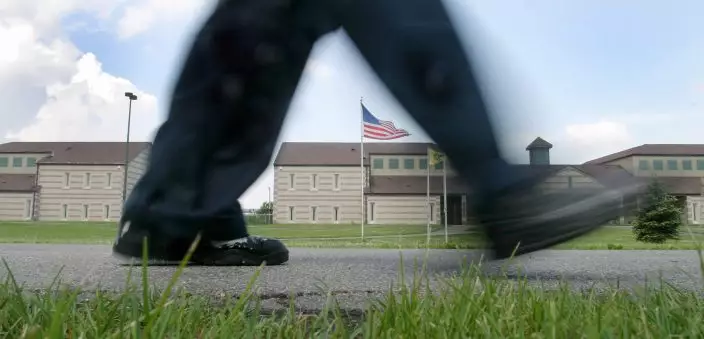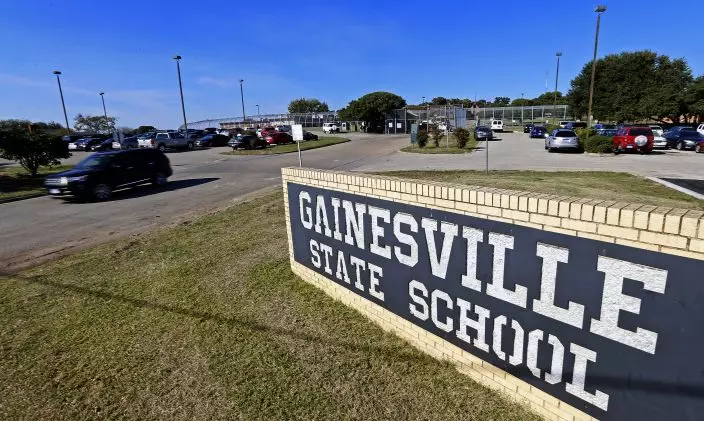A new federal report has found the number of kids who say they have been sexually victimized in juvenile detention centers has dropped across the U.S. compared with past years. But remarkably high rates of sexual abuse persist in 12 facilities stretching from Oregon to Florida, according to the Bureau of Justice Statistics report released Wednesday.
The report analyzed data collected during more than 6,000 anonymous interviews last year at nearly 330 juvenile detention facilities. Young people were asked about any forced or coerced sexual contact they experienced, whether by staffers or other kids, ranging from rape to unwanted touching to being shown sexual pictures or movies.
Nationwide, an estimated 7.1% of children in juvenile facilities reported being sexually victimized during the previous 12 months, the report said. That’s a drop compared with the last time the survey was done in 2012, when 9.5% of youth reported being victimized.

FILE - In this May 18, 2004 file photo, an inmate walks at the Circleville Juvenile Correctional Facility outside Circleville, Ohio. A new federal report has found the number of kids who say they've been sexually victimized while in juvenile detention centers is dropping across the U.S. compared to years past. But remarkably high rates of sexual victimization persist in 12 facilities stretching from Oregon to Florida, including Circleville, according to the U.S. Bureau of Justice Statistic's special report released Wednesday, Dec. 11, 2019. (Tim RevellThe Columbus Dispatch via AP, File)The Columbus Dispatch via AP)
“Today’s report shows that the juvenile detention system is making long overdue strides in preventing sexual abuse,” Lovisa Stannow, executive director of Just Detention International, an organization seeking to end sexual abuse in detention, said in a statement. “But even one sexual assault is too many and, as the report makes clear, this violence remains commonplace in youth facilities across the U.S.”
Twelve facilities had dramatically higher rates of sexual victimization, including three juvenile residential centers in Florida, three in Texas, and one each in Oregon, Arkansas, Idaho, Georgia, Ohio and New Jersey, according to the report.
At the Liberty Juvenile Unit for Specialized Treatment in Florida, just over 26 percent of youth reported being sexually victimized in the past 12 months. Similarly high rates — about 22% and 21% — were reported at the Hastings Comprehensive Mental Health Treatment Program and Gulf Academy, both in Florida.

FILE - In this April 26, 2007 file photo, a group of male inmates prepare to march back to their dorm following lunch at The Gainesville State School in Gainesville, Texas. A new federal report has found the number of kids who say they've been sexually victimized while in juvenile detention centers is dropping across the U.S. compared to years past. But remarkably high rates of sexual victimization persist in 12 facilities stretching from Oregon to Florida, including Gainesville, according to the U.S. Bureau of Justice Statistics special report released Wednesday, Dec. 11, 2019. (Mona ReederThe Dallas Morning News via AP, File)
At the Juvenile Correctional Center in the small eastern Idaho town of St. Anthony, nearly 13 percent of youths reported being sexually victimized within the last 12 months. Roughly 500 miles (805 kilometers) north in a Lewiston, Idaho, juvenile correctional center, meanwhile, no incidents of sexual victimization were reported.
Neither Idaho nor Florida officials immediately responded to requests for comment from The Associated Press.
“The fact that we see such variability across and within states of course heightens the need to ensure that we’re asking every child so we really understand what the victimization looks like,” said Marsha Levick, chief legal officer for the Juvenile Law Center, a rights organization within the child welfare and justice systems.

FILE - This Friday, Oct. 28, 2016 photo, shows the Gainesville State School for juveniles in Gainesville, Texas. A new federal report has found the number of kids who say they've been sexually victimized while in juvenile detention centers is dropping across the U.S. compared to years past. But remarkably high rates of sexual victimization persist in 12 facilities stretching from Oregon to Florida, including Gainesville, according to the U.S. Bureau of Justice Statistic's special report released Wednesday, Dec. 11, 2019. (Jae S. LeeThe Dallas Morning News via AP, File)
Levick said the findings also raise concerns about the level of oversight states have over each problematic facility and whether enough is being done to uncover and respond to sexual abuse.
“They need to step it up, quite frankly,” she said.
Research shows that trauma inflicted on kids in residential programs like detention centers increases the risk that they will experience mental health problems, have delays in their educational progress or harm themselves or others, Levick said.
“We removed these children from their homes, we have an obligation to keep them safe,” she said. “We do it because we claim we’re going to treat them, provide them an opportunity for rehabilitation, but if they are victimized in those facilities, we have failed them.”
The previous Bureau of Justice Statistics report included information about kids' demographics, along with the finding that gay, lesbian, bisexual and transgender young people were abused at a far higher rate than others.
The newest report doesn’t include that data yet. The information will be analyzed and published in a future report, Bureau of Justice Statistics unit chief Erica Smith said.
She said Wednesday's report was a “summary version" that focuses on information the bureau is required to collect under federal law.
“A lot of that additional, really rich contextual information that we included for that first report, it's all on deck to be published, it's just not part of this first release of information,” Smith said.
The report also didn’t include information about the circumstances surrounding the incidents, which was previously included.
Stannow of Just Detention International said the absence of the demographic information is baffling.
“It’s clear that we’re making progress in the effort to prevent sexual abuse, but leaving out this information means that advocates and corrections officials alike have to move forward with one arm tied behind our backs,” Stannow said in a statement.
Smith said the report's findings are “generally a good story.”
“The real takeaway is that we are seeing a reduction in the total prevalence of sexual victimization, and that is essentially across the board,” she said.
It's too soon to tell if the drop is tied to a federal law that began requiring states in 2012 to meet standards designed to reduce and prevent sexual abuse behind bars, Smith said. Future reports will help determine if the Prison Rape Elimination Act is making a difference, she said.


